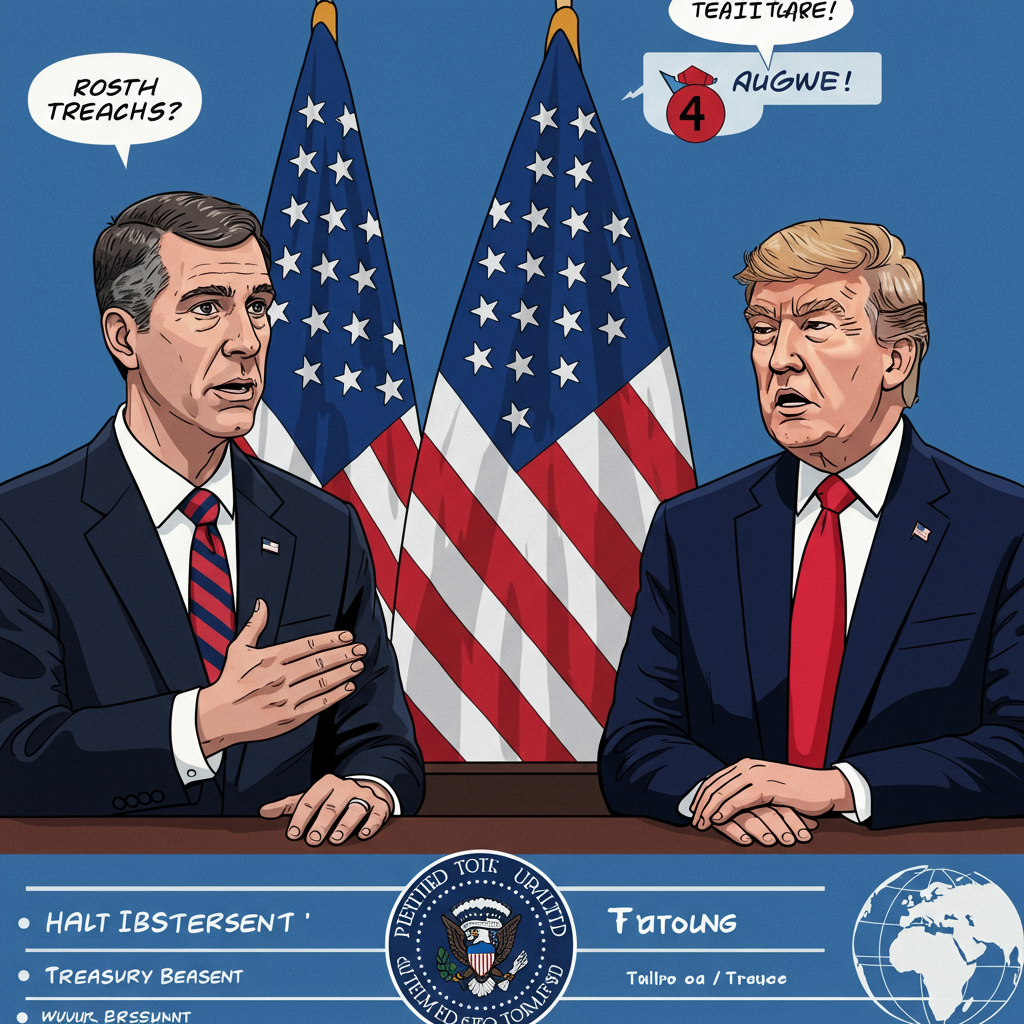The landscape of global trade is set for a significant shift. Starting august 1, the United States will reinstate steeper tariff rates on goods from countries that haven’t finalized new trade agreements with Washington. This confirmation comes from Treasury Secretary Scott Bessent and echoes recent statements by President Trump, signaling a firm deadline for trading partners to secure alternative arrangements or face increased import duties.
This move effectively resets the clock following a previous pause in tariff implementation. While the administration insists August 1 isn’t a “new deadline” but a set date for action, it places intense pressure on nations currently negotiating with the U.S. The potential return to higher tariff levels, some reaching what the administration calls “very high levels,” highlights the high stakes for international commerce and the global economy.
The August 1 Tariff Date Explained
The upcoming August 1 date marks a critical point for U.S. trade policy. It signifies the end of a temporary suspension on elevated tariff rates that President Trump initially announced on April 2. At that time, the administration had proposed a 10% duty on imports from nearly all trading partners, with plans for significantly higher rates on specific countries shortly thereafter. The subsequent pause, originally set to expire around July 9, was intended to create space for diplomatic negotiations and trade deal finalization.
Treasury Secretary Bessent clarified in recent interviews that absent a successful trade deal by August 1, these previously announced, sometimes substantial rates will automatically “boomerang back” into effect. This means countries without a finalized agreement will face the higher duties outlined in the initial April plan. The administration frames this not as extending or creating a deadline, but rather as stating a definitive date by which pre-existing tariff rates will be triggered for those still without a deal. It’s a strategic pivot designed to compel partners toward swift agreement.
From Negotiations to Notifications
Adding to the urgency, President Trump indicated his administration would simplify the process for some countries by sending direct notification letters. These letters, with an initial batch targeting about a dozen nations, outline the specific tariff rates imports from those countries will face starting August 1 if no deal is reached. This approach signals a shift, moving from prolonged negotiation with potentially hundreds of partners towards a more direct, “take it or leave it” mandate for those lagging in talks.
Officials suggest around 100 trading partners could initially face a minimum “reciprocal” tariff rate of 10% under this new phase. While earlier hopes included reaching numerous comprehensive deals quickly, the reality is that only a few have been finalized so far. This necessitates a period of intense, last-minute activity as countries scramble to reach concessions or secure agreements before the August 1 implementation date. The use of formal letters underscores the administration’s intent to move forward with implementation if deals aren’t struck.
The State of U.S. Trade Deals: Progress and Stalemates
The push towards the August 1 tariff trigger comes amidst a complex web of ongoing trade discussions. The administration’s strategy, described by Secretary Bessent as applying “maximum pressure,” has yielded some results but also faced significant resistance from key partners.
Successes include finalizing trade agreements with the United Kingdom and Vietnam. Under the Vietnam deal, imports will face a 20% tariff, a notable reduction from the 46% rate previously threatened, though a higher 40% tariff will apply to goods identified as transshipping from a third country (like China) through Vietnam. Additionally, Washington and Beijing have agreed to a temporary lowering of some existing high levies on each other’s products, signaling a partial de-escalation in specific areas, even as broader trade tensions persist.
However, progress is uneven. While the U.S. administration is reportedly “close to several deals” and anticipates “big announcements” soon, several major trading blocs and nations remain either resistant or engaged in difficult negotiations.
Key Negotiating Partners: A Mixed Picture
The European Union is cited by Bessent as an example where the “maximum pressure” strategy is proving effective, noting “very good progress” after initial slow movement. EU and U.S. negotiators have been actively engaged in talks, with hope expressed for a deal recently. The EU has reportedly signaled a willingness to accept a universal 10% tariff on many exports but is seeking crucial exemptions for sectors like pharmaceuticals, alcohol, semiconductors, and commercial aircraft. This comes after previous U.S. threats of much higher, potentially 50% tariffs on some EU goods.
In contrast, talks with Japan have reportedly soured. Prime Minister Shigeru Ishiba stated his country “won’t easily compromise,” particularly after President Trump suggested seeking potentially even higher tariffs, possibly exceeding 30%. South Korea is actively seeking an extension to the timeframe, proposing specific manufacturing partnerships and tariff reductions on products like automobiles.
The situation with China, while seeing temporary tariff relief on some items and easing of specific export restrictions (like chip design software), is complex. Concurrently, China has initiated retaliatory measures against the EU following EU duties on electric vehicles, including targeting European brandy and launching investigations into pork and dairy, highlighting the interconnectedness and risks of global trade disputes.
Indonesia has reportedly offered significant concessions, including cutting duties on key U.S. imports to “near zero” and committing to substantial purchases of U.S. wheat, aiming to avoid the higher tariffs. Canada, having removed a planned digital services tax, has resumed talks and is aiming for a deal by mid-July. Thailand is also reworking its trade proposal framework following initial ministerial-level talks.
Economic Impact and Uncertainty
The looming August 1 deadline and the potential return of higher US trade tariffs introduce a significant layer of uncertainty into the global economic outlook. Experts note that the original tariff chaos earlier in the year contributed to drops in CEO and consumer confidence and triggered financial market volatility. The current situation risks reigniting similar concerns.
The potential for tariffs ranging up to 60% or 70% on certain goods creates unpredictable costs for importers, exporters, and ultimately, consumers. While the administration frames this as a necessary tactic to secure more favorable trade terms for the U.S., trading partners and international bodies like BRICS nations view these unilateral tariff actions critically, with some leaders anticipating labeling them “illegal” and harmful to the global economy.
The uncertainty surrounding which specific rates will apply to which products from which countries complicates business planning, investment decisions, and supply chain management. Data has previously shown U.S. container import tariffs averaging around 21% amidst these trade tensions, a figure likely to fluctuate based on the outcome of the current negotiations or the lack thereof. The coming days leading up to August 1 will be crucial in determining the immediate trajectory for global trade relations and economic stability.
Frequently Asked Questions
What exactly happens on August 1 regarding US tariffs?
On August 1, unless a specific trade deal is reached with the United States beforehand, tariffs on imports from countries without a deal are scheduled to revert to the higher levels initially announced by President Trump on April 2. This means suspended duties could automatically become effective at potentially much steeper rates than currently applied.
Which countries are involved or making progress on deals to avoid higher US tariffs?
Several countries and blocs are in negotiations or have recently reached agreements. Successes include deals with the United Kingdom and Vietnam. China and the U.S. have also temporarily lowered some tariffs. Ongoing intense talks are occurring with the European Union, where progress is noted. Other countries like South Korea, Japan, Canada, Thailand, and Indonesia are also actively engaged in discussions or seeking concessions, though stances vary from seeking extensions to expressing resistance.
How could these returning US tariffs affect businesses and the global economy?
The potential reinstatement of higher tariffs introduces significant economic uncertainty. Businesses relying on imports from affected countries could face increased costs, which may be passed on to consumers. Exporters might face retaliatory tariffs from trading partners. This unpredictability can negatively impact CEO and consumer confidence, potentially causing volatility in financial markets and disrupting global supply chains.



